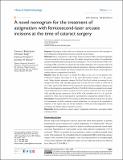| dc.contributor.author | Baharozian, Connor J | en_US |
| dc.contributor.author | Song, Christian | en_US |
| dc.contributor.author | Hatch, Kathryn M | en_US |
| dc.contributor.author | Talamo, Jonathan H | en_US |
| dc.date.accessioned | 2017-12-06T05:51:22Z | |
| dc.date.issued | 2017 | en_US |
| dc.identifier.citation | Baharozian, Connor J, Christian Song, Kathryn M Hatch, and Jonathan H Talamo. 2017. “A novel nomogram for the treatment of astigmatism with femtosecond-laser arcuate incisions at the time of cataract surgery.” Clinical Ophthalmology (Auckland, N.Z.) 11 (1): 1841-1848. doi:10.2147/OPTH.S141255. http://dx.doi.org/10.2147/OPTH.S141255. | en |
| dc.identifier.issn | | en |
| dc.identifier.uri | http://nrs.harvard.edu/urn-3:HUL.InstRepos:34492215 | |
| dc.description.abstract | Purpose The purpose of this study was to determine an arcuate incision (AI) nomogram to treat astigmatism during femtosecond laser-assisted cataract surgery. Methods: This is a retrospective, cohort study. Femtosecond laser (FSL)-assisted transepithelial AIs were created at a 9.0 mm optical zone, 80% depth, centered on the limbus. We modified the manual Donnenfeld limbal relaxing incision nomogram to 70% for with-the-rule (WTR), 80% for oblique (OBL), and 100% for against-the-rule (ATR) astigmatism. The correction index (CI) equaled AI-induced astigmatism/target-induced astigmatism. Measures included preoperative keratometric corneal cylinder (Pre Kcyl), postoperative Kcyl (Post Kcyl), and postoperative residual refractive astigmatism (Post RRA). Results: Mean Pre Kcyl and 1–2 months Post RRA in 161 eyes of 116 patients were 0.626±0.417 diopters (D) (range 0.5–2 D), and 0.495±0.400 D (range 0–1.5 D), respectively. Mean absolute astigmatic changes (Pre Kcyl–Post Kcyl) without accounting for axis change in the WTR, ATR, and OBL groups were 0.165±0.383 D (P<0.001), 0.374±0.536 D (P<0.001), and 0.253±0.416 D (P=0.02), respectively. Mean absolute astigmatic changes using RRA as the postoperative measurement (Pre Kcyl–Post RRA) without accounting for axis change were 0.440±0.461 D (P<0.001), 0.238±0.571 D (P<0.05), 0.154±0.450 (P=0.111) in WTR, ATR, and OBL groups, respectively. CIs for WTR, ATR, and OBL were 0.53, 1.01, and 0.95, respectively. There were no intraoperative or postoperative complications related to the AIs. Conclusion: Transepithelial FSL-AIs using the modified Donnenfeld nomogram show potential for management of mild to moderate corneal astigmatism. An increase in the magnitude or reduction of the optical zone size for the treatment of WTR and ATR astigmatism for this nomogram may further improve refractive accuracy. | en |
| dc.language.iso | en_US | en |
| dc.publisher | Dove Medical Press | en |
| dc.relation.isversionof | doi:10.2147/OPTH.S141255 | en |
| dc.relation.hasversion | http://www.ncbi.nlm.nih.gov/pmc/articles/PMC5648302/pdf/ | en |
| dash.license | LAA | en_US |
| dc.subject | femtosecond laser | en |
| dc.subject | cataract surgery | en |
| dc.subject | astigmatism | en |
| dc.subject | keratotomy | en |
| dc.subject | nomogram | en |
| dc.subject | limbal relaxing incisions | en |
| dc.title | A novel nomogram for the treatment of astigmatism with femtosecond-laser arcuate incisions at the time of cataract surgery | en |
| dc.type | Journal Article | en_US |
| dc.description.version | Version of Record | en |
| dc.relation.journal | Clinical Ophthalmology (Auckland, N.Z.) | en |
| dash.depositing.author | Song, Christian | en_US |
| dc.date.available | 2017-12-06T05:51:22Z | |
| dc.identifier.doi | 10.2147/OPTH.S141255 | * |
| dash.contributor.affiliated | Hatch, Kathryn | |
| dash.contributor.affiliated | Song, Christian | |
| dash.contributor.affiliated | Talamo, Jonathan | |


